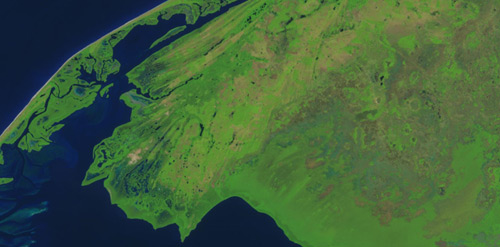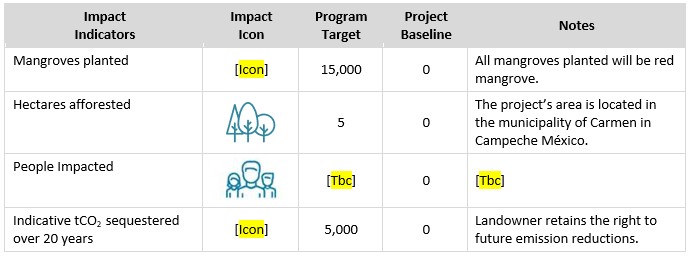Bahamitas Project Overview
Bahamitas mangrove conservation and restoration project is 3,560 hectares located on Laguna de Términos in Campeche, Mexico. The project has been implemented and operated with a local community cooperative and is an example of how community participation programs can successfully conserve and restore high value forest areas. Since 2016, its primary objective has been to restore and reforest over 2,400 hectares of degraded mangrove area and conserve 1,100 hectares of pristine mangrove ecosystems. By involving the local community and obtaining their participation, the project has essentially guaranteed the sustainability and successful outcome of its goals. By the restoration activities, environmental services provided by the coastal wetlands were recovered, such as: quality of habitat for fish and birds, improved water quality, and high volume of carbon sequestration and storage. This strategy is part of what we call the ecosystem-based adaptation strategy.
The success of this strategy has been to seek the participation of all those involved in decision-making from planning, preferably under a community participation scheme, which implies a constant dialogue between the actors, to share experiences, establish multiple objectives through joint deliberation between the different levels and establish the appropriate conservation strategies for each particular case.
In this way, the management and restoration actions in the degraded mangrove area within the Laguna de Términos contemplated that the benefit obtained from the restoration of the mangrove ecosystem had a more evident impact on the local people due to the direct use (tangible and intangible) of resources. To implement the restoration and rehabilitation measures of degraded mangrove areas, a participatory planning process was used that includes the organization of workshops and socialization meetings, as well as training in the different restoration activities. Such activities include hydrological rehabilitation through de-silting of the water channels in the mangroves by the members of the community. The transfer of knowledge from community to community has also had excellent results, as is the case of the formation of the cooperative “Community of mangrove restorers in Isla Aguada”, who have gained experience in mangrove conservation and restoration activities and continue to train other communities.
Conservation and restoration has brought economic benefits to the local community with both permanent and temporary jobs as well as future opportunities for the development of ecotourism activities. These restored mangroves became of greater importance due to the recovery of biodiversity, especially fish and birds that have economic importance. In addition to the improved water quality, storms have less severe effect on local communities. Through the participation and integration of the local community in the management and planning processes of these wetlands, local communities now understand why measures are needed to protect and preserve these high value ecosystems. Urban wetlands preserved in good condition, contribute to making cities and towns safer from the manifestations of climate change.
Project Area Highlights:
- 15,040 Ha Mangrove
- 12,840 Ha Conservation
- 2,200 Ha Restoration
- 3,850,000 tCO2 Avoided
- 5,790,000 tCO2 Sequestered
Additional Information

KML File available for download
[real3dflipbook id=”4″]
Project Supplemental Information
(Click to start the presentation)
Sustainable Development Goals (SDGs) and Impacts
For a full list and explanation of each SDG, click here
Project Impacts and Outcomes

Related Imagery and Resources
Ongoing Field Worklog Notes
B1-2019 Ground-truth and site visit
Lorem ipsum dolor sit amet lectus quisque taciti ultrices ornare nec mauris tellus nullam platea ante consectetur placerat nam malesuada erat iaculis sapien magna morbi tempus tortor volutpat fringilla pretium porta hac libero pulvinar eleifend ex feugiat pharetra laoreet eu tristique luctus maecenas fusce volutpat finibus vestibulum eros viverra amet
